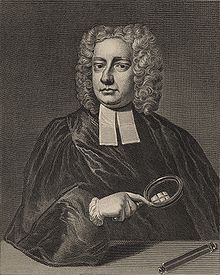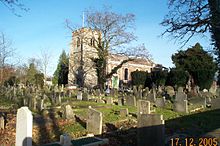John Theophilus Desaguliers
John Theophilus Desaguliers (born March 13, 1683 in La Rochelle , France , † February 29, 1744 in Covent Garden , Great Britain ) was a natural philosopher, scientist and inventor and clergyman in the Church of England .
Live and act

Desaguliers was born into a Huguenot family and fled to England in 1694 at the age of 11 to avoid the consequences of the revocation of the Edict of Nantes . In 1705 he graduated from Oxford with a Bachelor of Arts . His reputation as a scientist was sealed not only by his three awards from the Royal Society , but also by his publication of his two-volume work A course of Experimental Philosophy . In 1713 he lectured on physics in London. In 1718 he graduated from Oxfort University in theology and received his doctorate .
On October 14, 1712, he married Joanna Pudsey, daughter of William and Anne Pudsey of Kidlington, near Oxford. Their marriage resulted in four sons and three daughters. Only two sons survived childhood.
John Theophilus Desaguliers was a clergyman in the Church of England . Through the intercession of James Brydges, 1st Duke of Chandos , he became parish pastor of St. Lawrence's in Little Stanmore.
Since July 29, 1714 he was a member of the Royal Society . He received the Copley Medal , the Royal Society's highest honor , in 1734, 1736 and 1741 . He received the award in 1741 for his discovery of the properties of electricity . He was friends with Sir Isaac Newton and supported him in his experiments. With his speeches and texts too, he was one of Newton's advocates. On December 3, 1735 he became a corresponding member of the Académie des sciences .
Desaguliers also improved the safety of Thomas Savery's steam pump by designing a valve . He also designed a method for the indirect heating of steam boilers with the help of water vapor in contrast to fire and was thereby able to significantly improve safety.
Freemasonry
Desaugliers is considered to be one of the fathers of grand lodge freemasonry . He was a member of the Masonic lodges Horne Tavern in Westminster and Lodge of Salomon's Temple on Hemmings Row. In 1719 he was elected third Grand Master of the first Grand Lodge of England , Deputy Grand Master in 1723 and 1725. In the Book of Old Duties , the first Grand Lodge constitution, he signed the dedication to John Duke of Montagu , the richest man in England at the time. He devoted a lot of time and work to setting up the grand lodge order. The reintroduction of toasts at the annual festival of the grand lodge and table chairs goes back to him . He also reformed the dress code from the Lodge Master and lodges official.
In 1731 Desaguliers was specially sent from the Grand Lodge of London and Westminster to Holland to accept Franz Stephan, Duke of Lorraine, into Freemasonry in The Hague at the beginning of June . Franz Stephan traveled to England a little later and received the master's degree in the Maid's Head Lodge in the country house of statesman Robert Walpole in Norfolk and left England again on December 9, 1731.
Death and descendants
Desaguliers fell ill with gout in his later years . He died after a long illness in his home ( Bedford Coffee House ), in Covent Garden , London , on February 29, 1744. He was buried on March 6 in the Savoy Chapel , Savoy Street, London.
He left two sons:
- John Theophilus (1718–1751) graduated from Oxford and became a clergyman. He died childless.
- Thomas Desaguliers (1721–1780) made a career in the British Army. On April 1, 1748 he was appointed Chief Firemaster at the Royal Arsenal . There he developed scientific principles for the production of cannons and the improvement of firepower . Furthermore, he supported and supervised the fireworks to the background of the concert by Georg Friedrich Händel in Green Park .
Works
- Fires Improv'd: Being a New Method of Building Chimneys, so as to Prevent Their Smoaking, from the French by Nicolas Gauger (London, 1715), mostly about an elaborate form of fire grate
- The Motion of Water and Other Fluids, from the French by Edmé Mariotte (London, 1718)
- The Mathematical Elements of Natural Philosophy, from the Latin by WJ's Gravesande (London, 1720)
- The Whole Works of Dr. Archibald Pitcairne, from the Latin (London, 1727), with G. Sewell
- An Account of the Mechanism of an Automaton, from the French by J. de Vaucanson (London, 1742).
- The Newtonian System, an Allegorical Poem (London, 1728), written on the accession of George II
- Appendix on the reflecting telescope, pp. 211-288 in William Brown's translation Dr. Gregory's Elements of Catoptrics and Dioptrics (London, 1735), which contains most of the correspondence between Newton and others relating to the development of Newton's form of that instrument in 1668 and subsequently
- A Dissertation Concerning Electricity (London, 1742), the French version of which (Bordeaux, 1742) received a prize awarded by the Académie de Bordeaux (Course of Experimental Philosophy, II, 335).
literature
- Desaguliers, John Theophilus . In: John Venn , John Archibald Venn (eds.): Alumni Cantabrigienses . A Biographical List of All Known Students, Graduates and Holders of Office at the University of Cambridge, from the Earliest Times to 1900. Part 1: From the earliest times to 1751 , volume 2 : Dabbs-Juxton . Cambridge University Press, Cambridge 1922, pp. 37 ( venn.lib.cam.ac.uk Textarchiv - Internet Archive ).
Web links
- Scientific biography
- Masonic Biography from Mackey's Encyclopedia of Freemasonry
- Entry to desaguliers; John Theophilus (1683-1744) in the Archives of the Royal Society , London
Individual evidence
- ↑ List of members since 1666: Letter D. Académie des sciences, accessed on November 6, 2019 (French).
- ^ John Theophilus Desaguliers, French-born scientist and inventor, 1725. Science & Society Picture Library . Retrieved April 11, 2012.
- ↑ Eugen Lennhoff, Oskar Posner, Dieter A. Binder: Internationales Freemaurerlexikon. Revised and expanded new edition of the 1932 edition, Munich 2003, ISBN 3-7766-2161-3 .
- ↑ HM Stephens: 'Desaguliers, Thomas (1721-1780)' In: rev. Jonathan Spain: Dictionary of National Biography . Oxford University Press.
- ↑ Great Britain. Board of Ordnance A description of the machine for the fireworks, with all its ornaments, and a detail of the manner in which they are to be exhibited in St. James's Park, Thursday, April 27, 1749, on account of the general peace, signed at Aix La Chapelle, 7 October 1748. Published by order of His Majesty's Board of Ordnance. London: printed by W. Bowyer, sold by R. Dodsley, and M. Cooper. 1749.
| personal data | |
|---|---|
| SURNAME | Desaguliers, John Theophilus |
| BRIEF DESCRIPTION | Natural philosopher |
| DATE OF BIRTH | March 13, 1683 |
| PLACE OF BIRTH | La Rochelle |
| DATE OF DEATH | February 29, 1744 |
| Place of death | Covent Garden |
